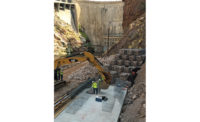Global Diving and Salvage of Seattle, Wash., was selected for the project and in early 2013, they began the massive effort of moving men and materials to Horse Mesa Dam. The location of the dam is extremely remote: it is more than 30 miles from the nearest major highway through twisting and turning two-lane roads. The final 6 miles is on a maintained dirt road that twists and turns its way through the canyon.
Nevertheless, Global Diving and Salvage hauled 29 tractor trailer loads that included the barge system that supports the construction efforts as well as housing, boats and other support features. The barge is the hub of operations. From this extremely miniaturized floating city, the 10- to 12-member crew support the divers that do the work.
“The people who do the real work on these types of jobs are the diving supervisors, the guys on the barge and the sat divers,” said Rick Heaslet, project manager for Global Diving and Salvage.
The first order of business for the divers was demolition and removal of the failed vanes. They were sliced and diced by wire saws into pieces approximately 4 feet by 4 feet and hauled out by a crane on the barge.
On the Horse Mesa Dam repair, there are two teams of two divers. Each team is trained not only as divers but also as construction personnel. Each team’s shift is 10 hours long and one diver remains in the diving bell — the vessel that brings them from the work area 160 feet below the surface of Apache Lake to their pressured habitation vessel on the barge — while the other works a five-hour shift. Roles are then reversed for the other five hours. Ten hours later, the second two-man crew repeats the process.
In order to have two crews working for approximately 20 hours a day, these divers remain under pressure in their barge located habitation unit, in the diving bell, or are working at the bottom of the lake for 30 days.
“I don’t know if this is true or not, but someone once told me that compared to a job you can do on the surface, any job you do underwater is three times harder,” said Spencer Dell, a Global Diving and Salvage diver who spent 30 days at Horse Mesa dam.
The new vanes are carbon steel forms coated with corrosion protection that will be filled by underwater concrete. The forms are being assembled by SRP. Global Diving and Salvage is currently working on the anchoring and support preparations and after the steel forms are secured into place, they will be filled with grout — a special non-aggregate concrete mixture especially developed for underwater pouring.
“The grout adds weight and stability,” said Frank Immel, marketing manager for Global Diving and Salvage.
Construction on the new guide vanes is expected to be complete by the end of August 2013.








Post a comment to this article
Report Abusive Comment